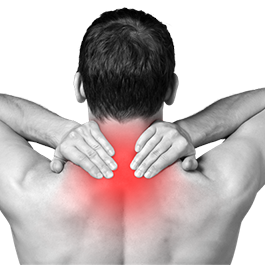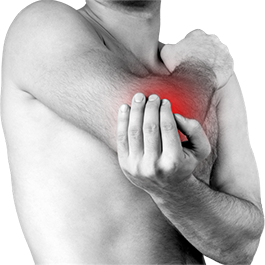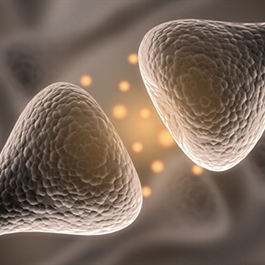Pain
 Pain is an unpleasant sensory and /or emotional experience associated with actual or potential tissue damage or described in terms of such damage.
Pain is an unpleasant sensory and /or emotional experience associated with actual or potential tissue damage or described in terms of such damage.
Chronic Pain has become AmericaŌĆÖs most common, expensive, and debilitating disorder, yet many doctors and chronic pain suffers know surprisingly little about the cause of pain and the wide variety of treatments that are available today.
Resolving chronic pain is not a simple problem. It is serious, multifaceted illness. It can deeply affect you, your friends, your marriage, your family and your job. Chronic pain is a problem of major proportion. Its diagnosis and treatment can frustrate patient and physician alike. In the United States, an estimated over 60 million people suffer from chronic pain and more then 15 million of these are partially or totally disabled because of the pain. Many of these pain problems are resistant to the strongest of analgesics (pain-killing medication) and may only respond slowly to prolonged administration of appropriate pain management.
Many chronic pain patients fail to respond to conventional treatment. They do not fit the usual acute patient model and they donŌĆÖt fit into the usual treatment plan. Therefore they may be labeled as having a purely emotional or ŌĆ£hystericalŌĆØ problem.
The presence of pain may mean disease (i.e., myofascial pain syndrome, fibromyalgia, etc.), but it does not always mean tissue damage. Today we know that pain is real and require immediate attention and treatment. If the pain is of a real nature, it is treated with medical approach. If the pain is produced by the mind (psychogenic), it is treated with psychological approach. Usually, chronic pain is a mixture of organic and emotional components.
Patients with chronic pain have frequently been rejected by the medical professionals because of the complexity of their problems. Patients usually see many doctors before seeing pain management specialist who can treat pain professionally.
Here is a common scenario: After a routine quick exam and review of X-rays are found to be negative, they usually be told: ŌĆ£ItŌĆÖs all in your headŌĆØ, or ŌĆ£You should be feeling fine by nowŌĆØ, or ŌĆ£YouŌĆÖll have to learn to leave with itŌĆØ. This type of thinking severely limits the physicianŌĆÖs vision and the patientŌĆÖs hope of getting well.
Many authorities in the medical field think of acute pain as having to do with something physically being wrong with you (broken bone, ruptured disc, etc.), but chronic pain is viewed as something psychologically wrong with you. With respect to acute pain, there is usually only one basis of thinking that is used to explain the pain problem. For example, in a rupture disc problem, the basis of thinking is purely mechanical, with the ruptured disc pressing on nerve root and causing the pain, numbness and weakness problems.
Today pin management physicians have the capability to ensure that patients who are injured or ill with pain-producing diseases not suffer. They can control acute pain after surgery. Cancer pain is also treatable for most patients. Pain management physician with adequate interventional pain training can control any type of pain using pain treatment modalities that were developed and ready to use when itŌĆÖs necessary.
Pain in the Neck
 Pain the neck, shoulder, and upper limb are among the most frequent causes of pain, suffering and disability. These painful disorders can be caused by infection or degenerative arthritic, or discs changes, trauma, myofascial pain syndromes, naturopathic disorders, and many other causes. Degenerative disk disease is thought to be the most often cause of chronic neck pain as is a dysfunctional segment. The other most common type of neck pain encountered in clinical practice is posttraumatic, or pain associated with whiplash-type movement, describing a hyperextension-hyperflexion neck injury.
Pain the neck, shoulder, and upper limb are among the most frequent causes of pain, suffering and disability. These painful disorders can be caused by infection or degenerative arthritic, or discs changes, trauma, myofascial pain syndromes, naturopathic disorders, and many other causes. Degenerative disk disease is thought to be the most often cause of chronic neck pain as is a dysfunctional segment. The other most common type of neck pain encountered in clinical practice is posttraumatic, or pain associated with whiplash-type movement, describing a hyperextension-hyperflexion neck injury.
Pain in the Back
 Disorders of the lower back, hip, and lower limbs cause pain, suffering and disability more frequently than disorders in any other part of the body. The most frequent cause of pain and disability in this region is degenerative discs disease, musculoskeletal disease or dysfunction of the lower back and lower limbs, followed by neuropathic disorder and peripheral vascular disease.
Disorders of the lower back, hip, and lower limbs cause pain, suffering and disability more frequently than disorders in any other part of the body. The most frequent cause of pain and disability in this region is degenerative discs disease, musculoskeletal disease or dysfunction of the lower back and lower limbs, followed by neuropathic disorder and peripheral vascular disease.
Osteoarthritis
 Osteoarthritis (OA) is an arthritis type that is caused by the breakdown and eventual loss of cartilage of one or more joints. The main areas, which are affected by OA, include fingers, spine and weight-bearing joints including hips, knees and feet.The condition of osteoarthritis is typically characterized by the breakdown of joint cartilage. Cartilage is a protein substance that serves as a ŌĆścushionŌĆÖ between the bones of the joints.
Osteoarthritis is also referred to as degenerative arthritis and is widely accepted as the most common form of arthritis.
Osteoarthritis (OA) is an arthritis type that is caused by the breakdown and eventual loss of cartilage of one or more joints. The main areas, which are affected by OA, include fingers, spine and weight-bearing joints including hips, knees and feet.The condition of osteoarthritis is typically characterized by the breakdown of joint cartilage. Cartilage is a protein substance that serves as a ŌĆścushionŌĆÖ between the bones of the joints.
Osteoarthritis is also referred to as degenerative arthritis and is widely accepted as the most common form of arthritis.
Fibromyalgia
 FMS (fibromyalgia syndrome) is a common disorder that causes pain in the muscles, ligaments and tendons, as well as fatigue. Most people with fibromyalgia syndrome (fms) experience aching all over. Sometimes the muscles twitch and at other times they burn. Fibromyalgia syndrome (fms) is characterized by ┬½tender points┬╗ ŌĆō points on the body which are unnaturally sensitive to touch. Fibromyalgia syndrome (fms) may also be associated with sleep disturbances, morning stiffness, irritable bowel syndrome, anxiety, and other symptoms. More women than men are affected by fibromyalgia syndrome (fms). Here we list some of the most prominent symptoms of the fibromyalgia syndrome:
FMS (fibromyalgia syndrome) is a common disorder that causes pain in the muscles, ligaments and tendons, as well as fatigue. Most people with fibromyalgia syndrome (fms) experience aching all over. Sometimes the muscles twitch and at other times they burn. Fibromyalgia syndrome (fms) is characterized by ┬½tender points┬╗ ŌĆō points on the body which are unnaturally sensitive to touch. Fibromyalgia syndrome (fms) may also be associated with sleep disturbances, morning stiffness, irritable bowel syndrome, anxiety, and other symptoms. More women than men are affected by fibromyalgia syndrome (fms). Here we list some of the most prominent symptoms of the fibromyalgia syndrome:
- Multiple tender areas on the back of the neck, shoulders, sternum, lower back, hips, shins, elbows and knees
- Fatigue
- Sleep disturbances
- Body aches
- Chronic facial muscle pain or aching
Treatment of fibromyalgia syndrome (fms) requires a comprehensive approach. Aerobic exercise, such as swimming or walking, improves muscle fitness and reduces muscle pain and tenderness. Heat and massage may also provide temporary relief. Using antidepressant medications may help elevate the mood, improve quality of sleep, and relax the muscles. People with fibromyalgia syndrome (fms) usually benefit from a combination of exercise, medication, physical therapy, and relaxation.
Complex Regional Pain Syndrome
Complex regional pain syndrome (CRPS) is a chronic pain condition. The key symptom of CRPS is continuous, intense pain out of proportion to the severity of the injury, which gets worse rather than better over time. CRPS most often affects one of the arms, legs, hands, or feet. Often the pain spreads to include the entire arm or leg. Typical features include dramatic changes in the color and temperature of the skin over the affected limb or body part, accompanied by intense burning pain, skin sensitivity, sweating, and swelling.
Doctors arenŌĆÖt sure what causes CRPS. In some cases the sympathetic nervous system plays an important role in sustaining the pain. Another theory is that CRPS is caused by a triggering of the immune response, which leads to the characteristic inflammatory symptoms of redness, warmth, and swelling in the affected area. Until recently neurologists couldnŌĆÖt do much for CRPS patients, but now a new therapy involving a drug and an operation is bringing hope. A small pump is inserted into the belly of CRPS patients. This pumps a drug called baclofen into the region around the spinal cord, restoring the braking mechanism.
Cancer Pain
Pain in Cancer is caused by a variety of reasons, including the disease itself, causing compression, inflammation or infiltration of local nerves.
Depending on the type and location of the pain, a number of different techniques maybe employed for treatment. Remember, cancer pain can be managed. With today's knowledge of cancer pain and the availability of pain-relieving therapies, no one should have to suffer from unrelieved pain. Although cancer pain can be relieved, surveys have shown that pain is often undertreated in many patients.
Myofascial Pain
Myofascial pain syndrome is a chronic local or regional musculoskeletal pain disorder that may involve either a single muscle or a muscle group. The pain may be of a burning, stabbing, aching or nagging quality. Importantly, where the patient experiences the pain may not be where the myofascial pain generator is located. This is known as referred pain. The pathophysiology of myofascial pain remains somewhat of a mystery due to limited clinical research; however, based on case reports and medical observation, investigators think it may develop from a muscle lesion or excessive strain on a particular muscle or muscle group, ligament or tendon. It is thought that the lesion or the strain prompts the development of a "trigger point" that, in turn, causes pain.
Shingles
The medical term for shingles is acute herpes zoster. Shingles is a skin rash that develops on half of the body, in a belt-like pattern. The rash is usually on either the right or left side of the chest, starting in the middle of the back and wrapping around to the breast -- but it can occur on any part of the body, such as the forehead and abdomen.
Most of the time, shingles is very painful. Sometimes the pain from shingles starts several days before the rash appears. When the pain starts before the skin rash, it can be very hard for doctors to make the correct diagnosis. Many patients have been told they have heart attacks, appendicitis, and migraine headaches before getting the correct diagnosis of shingles.
Polyneuropathy
 Polyneuropathy is defined as a neurological disorder typically characterized by the simultaneous malfunction of many peripheral nerves throughout the body. Quite often, the same nerves are affected symmetrically on both sides of the body, usually in the arms or legs. In fact, polyneuropathy is also referred to as the ŌĆśGlove and Stocking NeuropathyŌĆÖ.
Polyneuropathy is defined as a neurological disorder typically characterized by the simultaneous malfunction of many peripheral nerves throughout the body. Quite often, the same nerves are affected symmetrically on both sides of the body, usually in the arms or legs. In fact, polyneuropathy is also referred to as the ŌĆśGlove and Stocking NeuropathyŌĆÖ.
Slipped Disc
With adult having some 80% chance of getting back pain at some point in their lives, who hasnŌĆÖt complained of an aching back? How many people have experienced the sudden pain of "throwing oneŌĆÖs back out?"
Fatigue or a twist or sharp movement, but occasionally, there has been an injury to the spine and medical attention is required. A slipped disc is one such common injury to the spine. It can be extremely painful, and may damage surrounding muscle and nerve systems. If pain is very severe, if it persists or worsens when you lie down, if it travels down your leg or if numbness sets in, then a doctor should be consulted. Despite the common name - "slipped disc", it doesnŌĆÖt really "slips" out, rather the gel-like material in the centre of the disc bulges into the spinal canal. A slipped disc is also known as a pro-lapsed intervertebral disc (PID), herniated or ruptured disc.
A disc is a small mass of elastic, gristle-like tissue. Located between each vertebra in the spinal column, discs act as shock absorbers for the spinal bones. Thick ligaments attached to the vertebrae hold the pulpy disc material in place.
Trigeminal Neuralgia
Trigeminal neuralgia is among the most common facial pain syndromes and has also been called tic doloreaux. While it may be caused by compressive blood vessels, tumors and vascular malformations, its basic pathophysiology (or pain mechanism) remains unknown. What is known is the sudden, stabbing, excruciating pain that it produces, which lasts only a few seconds and affects the face.
Acute Pain
Acute pain usually starts suddenly, may be sharp, and often triggers visible bodily reactions such as sweating, an elevated blood pressure, and more. Acute pain is generally a signal of rapid-onset injury to the body, and it resolves when pain relief is given and/or the injury is treated.